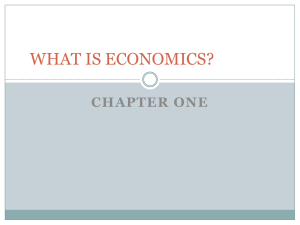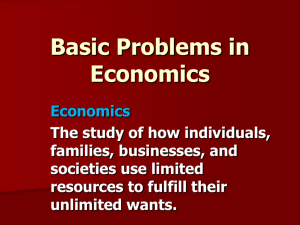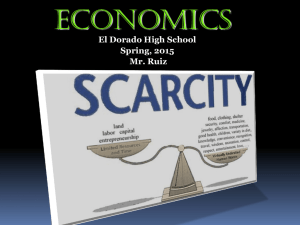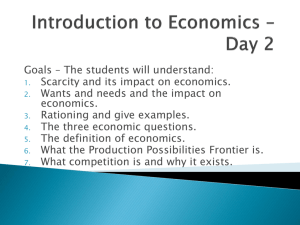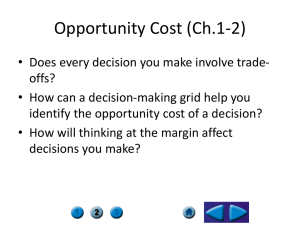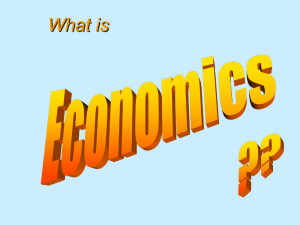Economics Chapter 1 Notes.pps
advertisement
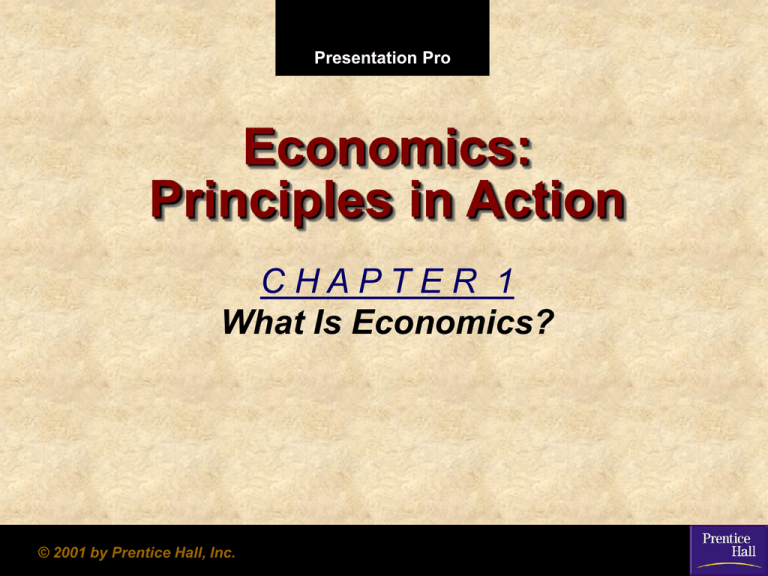
Presentation Pro Economics: Principles in Action CHAPTER 1 What Is Economics? © 2001 by Prentice Hall, Inc. CHAPTER 1 What Is Economics? SECTION 1 Scarcity and the Factors of Production SECTION 2 Opportunity Cost SECTION 3 Production Possibilities Graphs Go To Section: 1 2 3 Chapter 1 SECTION 1 Scarcity and the Factors of Production • What is economics? • How do economists define scarcity? • What are the three factors of production? Go To Section: 1 2 3 Chapter 1, Section 1 What Is Economics? Economics is the study of how people make choices to satisfy their wants. For example: •You must choose how to spend your time. •Businesses must choose how many people to hire. Go To Section: 1 2 3 Chapter 1, Section 1 Scarcity and Shortages Scarcity occurs Shortages occur when there are when producers limited quantities will not or cannot of resources to offer goods or meet unlimited services at needs or desires. current prices. Go To Section: 1 2 3 Chapter 1, Section 1 The Factors of Production • Land All natural resources that are used to produce goods and services. • Labor Any effort a person devotes to a task for which that person is paid. • Capital Any human-made resource that is used to create other goods and services. Go To Section: 1 2 3 Chapter 1, Section 1 The Factors of Popcorn Production Land Labor Capital Popping Corn The human effort needed to pop the corn Corn-Popping Device Vegetable Oil Go To Section: 1 2 3 Chapter 1, Section 1 Section 1 Review 1. What is the difference between a shortage and scarcity? (a) A shortage can be temporary or long-term, but scarcity always exists. (b) A shortage results from rising prices; a scarcity results from falling prices (c) A shortage is a lack of all goods and services; a scarcity concerns a single item. (d) There is no real difference between a shortage and a scarcity. 2. Which of the following is an example of using physical capital to save time and money? (a) hiring more workers to do a job (b) building extra space in a factory to simplify production (c) switching from oil to coal to make production cheaper (d) lowering workers’ wages to increase profits Want to connect to the Economics link for this section? Click Here! Go To Section: 1 2 3 Chapter 1, Section 1 SECTION 2 Opportunity Cost • Does every decision you make involve tradeoffs? • How can a decision-making grid help you identify the opportunity cost of a decision? • How will thinking at the margin affect decisions you make? Go To Section: 1 2 3 Chapter 1, Section 2 Trade-offs and Opportunity Cost All individuals and groups of people make decisions that involve trade-offs. Trade-offs are all the alternatives that we give up whenever we choose one course of action over others. The most desirable alternative given up as a result of a decision is known as opportunity cost. Go To Section: 1 2 3 Chapter 1, Section 2 The Decision-Making Grid Economists encourage us to consider the benefits and costs of our decisions. Karen’s Decision-making Grid Alternatives Sleep late Benefits Wake up early to study • Enjoy more sleep • Better grade on test • Have more energy during the day • Teacher and parental approval • Personal satisfaction Decision Opportunity cost Benefits forgone Sleep late Wake up early to study for test Extra study time Extra sleep time • Better grade on test • Enjoy more sleep • Teacher and parental approval • Have more energy during the day • Personal satisfaction Go To Section: 1 2 3 Chapter 1, Section 2 Thinking at the Margin When you decide how much more or less to do, you are thinking at the margin. Options Benefit Opportunity Cost st Grade of C on test One hour of sleep nd Grade of B on test 2 hours of sleep rd Grade of B+ on test 3 hours of sleep 1 hour of extra study time 2 hour of extra study time 3 hour of extra study time Go To Section: 1 2 3 Chapter 1, Section 2 Section 2 Review 1. Opportunity cost is (a) any alternative we sacrifice when we make a decision. (b) all of the alternatives we sacrifice when we make a decision. (c) the most desirable alternative given up as a result of a decision. (d) the least desirable alternative given up as a result of a decision. 2. Economists use the phrase “guns or butter” to describe the fact that (a) a person can spend extra money either on sports equipment or food. (b) a person must decide whether to manufacture guns or butter. (c) a nation must decide whether to produce more or less military or consumer goods. (d) a government can buy unlimited military and civilian goods if it is rich enough. Want to connect to the Economics link for this section? Click Here! Go To Section: 1 2 3 Chapter 1, Section 2 SECTION 3 Production Possibilities Graphs • What is a production possibilities graph? • How do production possibilities graphs show efficiency, growth, and cost? • Why are production possibilities frontiers curved lines? Go To Section: 1 2 3 Chapter 1, Section 3 Production Possibilities • A production possibilities graph shows alternative ways that an economy can use its resources. The production possibilities frontier is the line that shows the maximum possible output for that economy. Production Possibilities Graph 25 Watermelons Shoes (millions of tons) (millions of pairs) 0 15 8 14 14 12 18 9 20 5 21 0 Shoes (millions of pairs) • 20 15 10 1 2 3 b (8,14) c (14,12) d (18,9) 5 0 Go To Section: a (0,15) A production possibilities frontier e (20,5) f (21,0) 5 10 15 20 25 Watermelons (millions of tons) Chapter 1, Section 3 Efficiency Go To Section: 1 2 3 Production Possibilities Graph 25 Shoes (millions of pairs) Efficiency means using resources in such a way as to maximize the production of goods and services. An economy producing output levels on the production possibilities frontier is operating efficiently. 20 S 15 a (0,15) b (8,14) c (14,12) 10 g (5,8) 5 d (18,9) e (20,5) A point of underutilization 0 5 10 f (21,0) 15 20 Watermelons (millions of tons) Chapter 1, Section 3 25 Growth Go To Section: 1 2 3 Production Possibilities Graph 25 Future production Possibilities frontier T Shoes (millions of pairs) Growth If more resources become available, or if technology improves, an economy can increase its level of output and grow. When this happens, the entire production possibilities curve “shifts to the right.” 20 S 15 a (0,15) b (8,14) c (14,12) 10 d (18,9) 5 e (20,5) f (21,0) 0 5 10 15 20 Watermelons (millions of tons) Chapter 1, Section 3 25 Cost Production Possibilities Graph 25 0 15 8 14 14 12 18 9 20 5 21 0 Shoes (millions of pairs) Watermelons Shoes (millions of tons) (millions of pairs) 20 15 c (14,12) 10 d (18,9) 5 0 5 10 15 20 25 Watermelons (millions of tons) Cost A production possibilities graph shows the cost of producing more of one item. To move from point c to point d on this graph has a cost of 3 million pairs of shoes. Go To Section: 1 2 3 Chapter 1, Section 3 Section 3 Review 1. A production possibilities frontier shows (a) farm goods and factory goods produced by an economy. (b) the maximum possible output of an economy. (c) the minimum possible output of an economy. (d) underutilization of resources. 2. An economy that is using its resources to produce the maximum number of goods and services is described as (a) efficient. (b) underutilized. (c) growing. (d) trading off. Want to connect to the Economics link for this section? Click Here! Go To Section: 1 2 3 Chapter 1, Section 3



